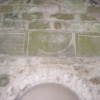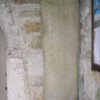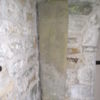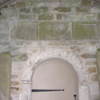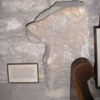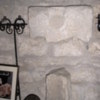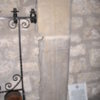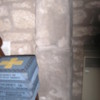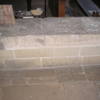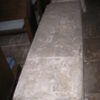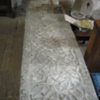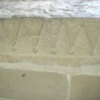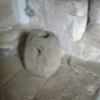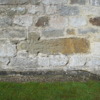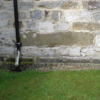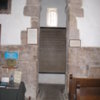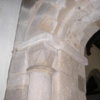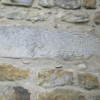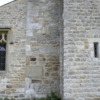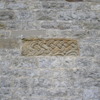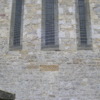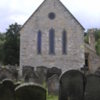St Gregory's Minster, Kirkdale, North Yorkshire
Title
St Gregory's Minster, Kirkdale, North Yorkshire
Subject
Archaeology
Description
St Gregory's is an Anglo-Saxon Church located in Kirkdale near Kirkby Moorside in North Yorkshire. The present building preserves a considerable amount of early Anglo-Saxon crosses and sculptural fragments built into the fabric of the church, which date to around AD 750 and it is likely that a church existed on this site in the sixth century. The church is most famous for the Saxon sundial, which has been preserved under the porch. The sundial dates from approximately 1055 to 1065, and the inscription reads:
(left panel) ORM GAMAL SVNA BOHTE S[AN]C[TV]S GREVORIVS MINSTER DONNE HI T WES AEL TO BROK (right panel) CAN & TO FALAN & HE HIT LET MACAN NEWAN FROM GRVNDE XPE (Criste) & S[AN]C[TV]S GREGORI VS IN EADWARD DAGVM C[Y]NG & [I]N TOSTI DAGVM EORL
(text on the sundial): PIS IS DAEGES SOLMERCA AET ILCVM TIDE
(beneath the sundial): PR[E]S[BYTER] & HAWARD ME WROHTE & BRAND
Translation:
(panels left to right): Orm Gamal's Son bought St Gregory's Minster when it was all broken down and fallen and he let it be made anew from the ground to Christ and St Gregory, in Edward's days, the King and in Tosti's days, the Earl.
(text on the sundial): This is day's SUn marker at every tide.
(text beneath the sundial): And Haworth, me wrought and Brand priests.
Orm Gamal's son is almost certainly the Orm who owned Chircheby during the time of Edward the Confessor (recorded in the Doomesday Book). It is assumed that Chircheby is Kirkdale (though the name is also probably reflected in Kirkby Moorside). The individual Tosti the Earl in the sundial text is the same Tostig, Earl of Northumbria, brother of Harold Godwineson, who was killed at the battle of Stamford Bridge in 1066. He held the office of Earl of Northumbria from 1055 until 1065, and therefore the sundial must have been made between 1055 and 1065.
For further information on the sundial, see S. A. J. Bradley, Orm Gamalson's Sundial: The Lily's Blossom and the Roses' Fragrance (1997 Kirkdale Lecture).
St Gregory's Minster also preserves two early highly ornamented Anglo-Saxon grave covers in the nave as well as numerous other cross-slab and early sculptural fragments.
(left panel) ORM GAMAL SVNA BOHTE S[AN]C[TV]S GREVORIVS MINSTER DONNE HI T WES AEL TO BROK (right panel) CAN & TO FALAN & HE HIT LET MACAN NEWAN FROM GRVNDE XPE (Criste) & S[AN]C[TV]S GREGORI VS IN EADWARD DAGVM C[Y]NG & [I]N TOSTI DAGVM EORL
(text on the sundial): PIS IS DAEGES SOLMERCA AET ILCVM TIDE
(beneath the sundial): PR[E]S[BYTER] & HAWARD ME WROHTE & BRAND
Translation:
(panels left to right): Orm Gamal's Son bought St Gregory's Minster when it was all broken down and fallen and he let it be made anew from the ground to Christ and St Gregory, in Edward's days, the King and in Tosti's days, the Earl.
(text on the sundial): This is day's SUn marker at every tide.
(text beneath the sundial): And Haworth, me wrought and Brand priests.
Orm Gamal's son is almost certainly the Orm who owned Chircheby during the time of Edward the Confessor (recorded in the Doomesday Book). It is assumed that Chircheby is Kirkdale (though the name is also probably reflected in Kirkby Moorside). The individual Tosti the Earl in the sundial text is the same Tostig, Earl of Northumbria, brother of Harold Godwineson, who was killed at the battle of Stamford Bridge in 1066. He held the office of Earl of Northumbria from 1055 until 1065, and therefore the sundial must have been made between 1055 and 1065.
For further information on the sundial, see S. A. J. Bradley, Orm Gamalson's Sundial: The Lily's Blossom and the Roses' Fragrance (1997 Kirkdale Lecture).
St Gregory's Minster also preserves two early highly ornamented Anglo-Saxon grave covers in the nave as well as numerous other cross-slab and early sculptural fragments.
Creator
Kelly A. Kilpatrick
Date
Anglo-Saxon, Late Saxon, modern
Language
English
Date Created
2010-09-16
Files
Citation
Kelly A. Kilpatrick, “St Gregory's Minster, Kirkdale, North Yorkshire,” Woruldhord, accessed April 20, 2024, http://poppy.nsms.ox.ac.uk/woruldhord/items/show/355.

